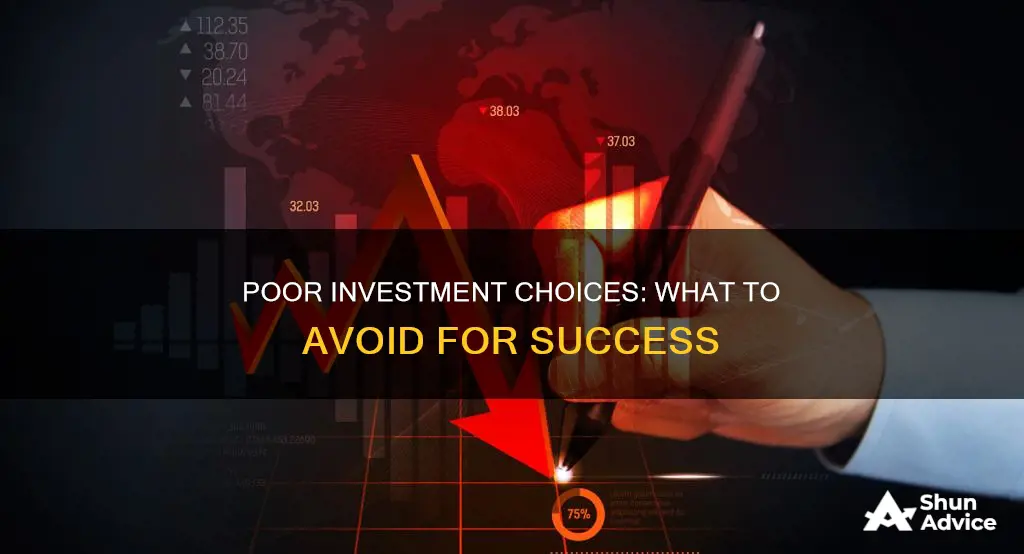
Investing is a great way to build wealth, but it's important to be able to distinguish between good and bad investments. A bad investment is one where you don't make a profit, or the profit is less than expected. There are several warning signs of a bad investment, including a sense of urgency to buy, an investment advisor pressuring you to buy, and a lack of transparency or positive evidence surrounding the investment. It's also a bad sign if you don't know much about the investment or if it's being touted as risk-free. Trust your instincts—if something feels shady, it probably is.
| Characteristics | Values |
|---|---|
| Hard to find information on | Bad investment |
| Lack of transparency | Bad investment |
| Lack of leadership and strategy | Bad investment |
| High fees | Bad investment |
| Lack of due diligence | Bad investment |
| High risk | Bad investment |
| Doesn't align with your goals | Bad investment |
| Too good to be true | Bad investment |
| Lack of diversification | Bad investment |
What You'll Learn

Lack of transparency and direction
Due diligence is essential when evaluating any investment prospect. If you find it challenging to obtain information about a company, its financial records, business plans, or leadership team, it could be a sign of a questionable investment. Reputable companies should be forthcoming with relevant information and provide potential investors with the necessary resources to make informed decisions.
Additionally, a lack of clear direction and leadership is another warning sign. A well-run business should have defined goals, strategies, and a competent management team. If you cannot identify the leaders of a company or understand their strategic vision and plans, it could indicate poor management or a lack of focus. Such companies often flounder and may not generate sustainable profits.
Furthermore, it is crucial to assess the ease of obtaining returns on your investment. If extracting profits from an investment requires excessive time, money, or risks, it may not be a prudent choice. These types of investments can be detrimental, especially if they fail to generate returns over an extended period or altogether.
When considering investment opportunities, it is essential to look for companies with focused plans, competent leadership, and a track record of success. A lack of transparency and direction can significantly increase the risk of an investment turning sour, potentially resulting in financial losses. Therefore, conducting thorough research and due diligence is vital to making informed investment decisions.
Diverse Investment Portfolios: Strategies, Risks, and Benefits
You may want to see also

High fees and excessive risks
A good investment will have a clear path to a high return. Its strategy will be sound, and it will include plans for how you will get your money back. Make sure these plans seem realistic and that you are comfortable with the time it will take to start seeing a profit.
A good investment will also allow for due diligence. You should be able to find information about the company, its leadership, and its strategy. A bad investment, on the other hand, will be hard to find information on. The company may not be very transparent, and there may not be many happy investors.
Additionally, it's important to be cautious of investments that seem too good to be true. If an investment opportunity promises guaranteed returns or claims to be risk-free, it's likely a scam. All investments carry some level of risk, and it's important to understand the risks involved before investing.
Finally, it's crucial to do your own research and seek advice from a qualified financial advisor before making any investment decisions.
Quick Investments: Strategies for Immediate Financial Returns
You may want to see also

No guaranteed returns
When it comes to investing, there is always an element of risk, and no guaranteed returns. Even the most well-researched and seemingly foolproof investments can sometimes go awry, and there are no sure things. This is an important concept to understand when considering investing—if there were guaranteed returns, everyone would be doing it!
The reality is that the majority of investments perform poorly when compared to certain benchmarks, such as gold. Historical data shows that this is true for bonds, stocks, and real estate. In fact, nearly all of these asset classes make for bad investments for outside passive investors. This is because the top-performing investments in these classes account for most of the returns, while the majority underperform.
For instance, if you had invested $100 in T-bills starting in 1928 and compounded them through 2023, you would have ended up with $2,249. However, if you had invested in longer-duration T-bonds, you would have turned $100 into $7,278. But this is not a true reflection of the value of the investment, as it is due to dollar debasement. If you had simply invested in gold, you would have turned $100 into $10,042. This is because the number of dollars in the U.S. broad money supply increased by more than 400 times from 1928 to 2023, diluting the value of the investment.
This example highlights the risk of investing and the fact that there are no guarantees. Even the safest investments, like U.S. Treasurys or CDs, are not entirely risk-free. Anyone who tells you an investment is risk-free is either being dishonest or doesn't understand the investment themselves—neither is a good sign.
Another example of the lack of guaranteed returns in investing can be seen in the performance of U.S. stocks. Studies have shown that a tiny percentage of equities make up almost all returns in equity markets. Just 4% of stocks accounted for nearly all stock market returns, while the remaining 96% of stocks only generated minor excess returns or matched T-bills.
Similarly, real estate, often considered a good long-term investment, may not always provide the expected returns. While some real estate investments have performed very well, others have gone to zero due to decreases in population and economic activity in the surrounding area. Most real estate falls somewhere in the middle, providing decent returns but often failing to outperform gold when maintenance and taxes are considered.
In conclusion, investing is a risky business, and there are no guaranteed returns. It's important to do your research, understand the risks, and make sure any investment aligns with your financial goals and risk tolerance. Even the safest investments carry some level of risk, and it's crucial to be aware of that before parting with your money.
India's Future: Investing in Petro?
You may want to see also

Misalignment with personal goals
When considering an investment, it is important to ensure that it aligns with your personal goals. Even if an investment seems attractive, it may not be the right choice for you if it does not fit your financial goals and risk tolerance. For instance, a diversified portfolio of stocks has been a great long-term investment strategy, but it may not be suitable for retirees who need a stable source of income and cannot handle the volatility associated with stocks.
Additionally, it's important to be cautious of investments that promise guaranteed returns or claim to be risk-free. All investments carry some level of risk, and if someone assures you otherwise, it could be a sign of a scam or a dishonest pitch.
Another sign of misalignment with personal goals is when an investment feels questionable or shady. Trust your instincts and do not invest if you feel uncomfortable with the opportunity or the way it is presented. Meet the people involved, assess their track record of dealing with investors and customers, and evaluate their business practices to ensure they align with your values.
Furthermore, consider your investment goals and whether the opportunity allows you to achieve them. For example, if you are seeking long-term wealth accumulation, short-term investments or those that offer quick returns may not align with your objectives. Ensure that the investment strategy, time horizon, and expected returns are consistent with your personal financial goals.
In conclusion, when evaluating potential investments, it is crucial to consider your personal goals and risk tolerance. By ensuring that the investment aligns with your objectives, you can make more informed and suitable decisions that contribute to your financial well-being.
Equity Investment: Understanding Classification and Its Impact
You may want to see also

Overly complex or difficult to understand
Some investments may seem attractive but are in fact opaque or difficult to understand. This complexity can make it hard to accurately assess the risks involved and whether the investment is suitable for your financial goals. For instance, cryptocurrency is a highly complex and speculative investment vehicle that has generated millions for some investors, but there are probably a thousand horror stories for each success story.
Information Availability
A bad investment will often be difficult to find information about. The company may not be very transparent, and there may be a lack of happy investors. If you do find information, but it seems too good to be true, it could also be a red flag. In contrast, a good investment will lead to positive evidence when conducting due diligence. You should be able to find information about the business's reputation, financial track record, and clear documentation of its successes and strategies.
Understanding the Investment
If you don't understand an investment, it's probably not a good idea to put your money into it. Educate yourself first about the specifics of the investment and the broader market or industry trends. This knowledge will help you make more informed decisions and avoid potential pitfalls. It's crucial to know what you are investing in and how you can succeed before committing your capital.
Gut Feeling
Trust your instincts when evaluating an investment opportunity. If something feels shady or like a scam, it probably is. Meet the people involved, understand their business practices, and assess how they treat their investors and handle their finances. If you feel uncomfortable with any aspect of the opportunity or its setup, it's best to avoid investing.
Seeking Advice
Consider seeking advice from a qualified financial advisor, especially for complex investments. It's important to work with an advisor who is a fiduciary, legally bound to act in your best interests. Avoid advisors who engage in hard-selling tactics and always do your own research to ensure the investment aligns with your financial goals and risk tolerance.
Creating an Investment Sheet: Excel Essentials
You may want to see also
Frequently asked questions
Some signs of a bad investment include:
- A sense of urgency to buy
- Lack of transparency and information
- No clear leadership or strategy
- Difficulty getting a return
Some examples of bad investments include:
- Whole life insurance
- Cryptocurrency and NFTs
- Real estate syndications
- Lottery tickets
Some red flags to look out for include:
- Being pressured by an investment advisor to buy
- Being told it's "the next big thing"
- Lack of understanding of the investment
- Being told it's risk-free
Some factors that can make an investment more likely to be a bad one include:
- High fees
- Lack of diversification
- Not aligning with your financial goals and risk tolerance







